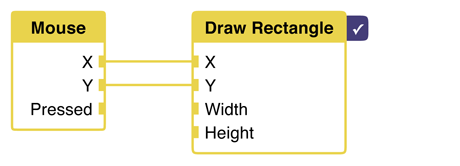
If you actually want to great a 3D model for printing or manufacturing an object with ventilation holes, NodeBox is not the tool you want.


Nodebox no repeat free#
Feel free to keep this dialog going.įirst I would need to get a clearer idea what you are trying to do. I might try noodling around with this some more. You could then create endless variations, each one unique. NodeBox would let you scrub various settings to get the effect you want. Once you have the nodes to express these concepts you can string them together in a myriad of different ways to create footprints composed of separate regions that fit together to form the overall pattern. For a softer edge you could do an ordinary compound then extract the inflection points and reconnect them with my curvify to produce more organic outlines. The shapes could then be fed into a clipping subnet that modifies shapes that cross the boundary of the shoe. You might find my curvify subnet useful for this ( ). You could start with rectangles or ellipses or polygons as base elements and then soften or distort them in different ways. The next step would be to build up methods for producing the shapes within each stack. That pattern of growth and shrinkage could itself be controlled by a "growth curve". You could then add an additional concept of controlling the size within a curve of shapes so that the shapes grow and shrink as they follow the curve. One useful component would be a curved stack that follows a supplied curve instead of a straight line. NodeBox currently lets you stack shapes like rectangles or ovals. One way of approaching this would be to develop a "language" of core concepts - which could be expressed by subnetworks. I begin to see what you mean by "organic". One thing I notice is that most shoe prints are organized around sinuous patterns that flow like a snake or a stream, following the natural curves of a foot. You've already made a great deal of progress, but this is a hard problem. It's a whole art form of compelling beauty that was right under my feet this whole time. Each one is different - and some are fabulously complex. I spent a few minutes looking at shoe print clip art and the soles of actual shoes, boots, and sneakers (two examples attached). If this technique doesn't work for you, send me an example of what you are trying to achieve and I could take another whack at it. If you want something fancier, maybe an Escher-like hyperbolic effect, you may need to do some trigonometry, but with determination almost anything is possible in NodeBox. This is a simple but somewhat crude technique since it only produces two sizes. I also wiggle and randomly rotate them for a less rigid (more organic?) look. If you look closely at the screenshot you can see that the stars around the edge of the footprint are smaller than the stars in the interior. When drawing the pattern I replace the dots with stars. I can use this fact to distinguish those boundary dots and make them smaller (instead of just clipping them). Dots on the boundary which get partially clipped will have some other pointCount. A normal dot (ellipse) has a pointCount of 13. I fill a grid with dots and use a compound node to clip them to the shape of a footprint. Making each element of the pattern change size as it approaches the boundary is trickier, but there are ways to do this.

You are already using the compound node to clip a repeating pattern inside the boundary of a shape. Could you post an example of the effect you are trying to create? I'm not entirely clear on what you mean by "organic".


 0 kommentar(er)
0 kommentar(er)
